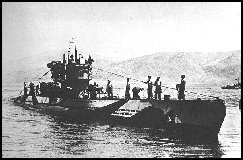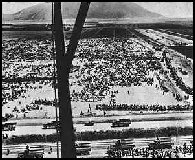April
27, 1943
In heavy fighting, British forces take
Djebel Bou in Tunisia.
Return to
the top
April
28, 1943
The
pro-Soviet Union of Polish Patriots issued a statement in Izvestia that
the Polish Government in exile (London) had never received a popular mandate and
that its policy regarding the executed Polish officers found in Katyn Woods by
the Germans was aimed at causing a rift between Britain, the United States, and
Russia.
Heavy
fighting continued at Djebel Bou Auoukaz as the German 8th Panzer
Regiment launched a major counterattack against the British units in the area.
Meanwhile, the US II Corps is making slow but steady progress in “Mousetrap
Valley.”
Return to
the top
April
29, 1943
An international medical commission
begins its investigation of the bodies found by the Germans in the Katyn Woods.
Autopsies are conducted on eight corpses. The commission concludes that the
bodies were indeed those of Polish officers and they had been killed sometime
during the spring of 1940.
In a 24-hour period, U-515, operating
off the coast of Freetown in West Africa, sunk five ships.
British
forces capture Sidi Abdallah.
Return to
the top
April
30,
1943
The Royal Navy officially adopts a new
strategy for combating submarines. The new strategy calls for carrier based
fighter to be deployed to protect long range anti-submarine patrol craft. The
plan was put in place in the Bay of Biscay where the submarines could be more
easily located coming and going from their bases in France. During the first
month, 38 submarines were sunk with this technique.
The Military Policy Committee of the
Manhattan Project, led by General Leslie Groves, begins to explore the
possibility of using "the bomb" against Japan rather than Germany.
Many of the scientists were working on the bomb project only because they feared
that Germany would develop the weapon first. No one believed the Japanese
science and industry capable of such a development and there would be many who
questioned the morality of a nuclear attack on Japan even before the device
existed.
Operation Mincemeat begins as the
British submarine Seraph releases a corpse into the sea off the Spanish
port of Huelva. The hope was the papers carried on the body would be passed on
to the Germans. The papers explained that the build-up and future air operations
against Sicily were a diversion from the real attack which was to be launched
against Greece. This, of course, was the deception. Operation Husky, the Allied
invasion of Sicily was the real attack.
In Tunisia, the Germans retake Djebel
Bou Aoukaz in heavy fighting. Meanwhile, the US II Corps gain ground against
Hill 609 and 8th Army renews its attacks between Bou Auokaz and Ksar
Tyr.
In an attempt to improve relations with
their Soviet allies, and after some major arm twisting by the British, the Polish government in exile requests that the Red Cross
enquiry into the Katyn massacre be dropped.
Return to
the top
May 1, 1943
The US II Corps takes Hill 609 in
"Mousetrap Valley." Axis forces begin to withdraw from the area.
Return to
the top
May 2, 1943
Japanese bombers based in Salamaua, New
Guinea strike Darwin Australia.
RAF Mosquito fighter-bombers raid the
railway yards at Thionville in France.
German Dornier bombers lay mines off
the Thames and Humber estuaries.
The
German transport Gneisenau strikes a mine and sinks, east of Gedser.
Return to
the top
May 3, 1943
US forces break out of “Mousetrap
Valley, and the US 1st Armored Division captures Mateur, 20 miles from Bizerte.
Return to
the top
May 4,
1943
After sailing for a week through raging
storms, westbound convoy ONS-5 makes contact with the German wolf pack sent to
destroy it. As German submarine U-630 was starting its attack run, a Canadian
RAF plane depth charged the boat, sinking it.
Japanese forces continue to press the
British defenders, this time infiltrating between Buthidaung and Maungdaw,
threatening the British supply lines.
Hitler
decides to postpone the summer offensive at Kursk until more of the new Tiger
and Panther tanks can be delivered to the troops. Many historians attempt to
claim that this was a major blunder because it gave the Soviets more time to
prepare. However, more recent evidence would indicate this is a false premise.
By mid-May, the Russians had prepared an extensive defense network that was more
than enough to defeat the Germans at Kursk.
In
an act of purest desperation, the Italian merchant ship Campobasso,
attempted to deliver desperately needed fuel and military supplies to the Axis
forces in Tunisia. It was intercepted and sunk by British destroyers.
Return to
the top
May 5,
1943
The Axis make one more attempt to
supply Tunisia, sending the San Antonio to her doom, this time at the
hands of American bombers. There would be no more attempts to supply Tunisia.
Convoy ONS-5, now being dogged by over
20 German submarines, begins to take serious losses. However, German submarine
U-192 is sunk.
Heavy
fighting continues on the Kuban peninsula as Red Army forces take Krymsk and
Neberjaisk from the German 17th Army.
After
taking and then losing the town in very heavy fighting, British forces recapture
Djebel Bou Aoukaz late in the day. This action secured the left flank for the
final drive on Tunis. he British 5th Corps is now commanded by Horrocks and
includes the 6th and 7th Armored Divisions and the 4th Indian Division.
Return to
the top
May 6,
1943
The British 5th Corps, consisting of 6th,
Armored, 7th Armored, and 4th Indian Divisions led by
Horrocks, breaks through the Axis
front, taking Massicault, and advancing toward Tunis. The attack is heavily
supported by air and artillery support and succeeds in destroying the remnants
of the German 15th Panzer Division. is Meanwhile, the US II Corps advanced
toward Bizerta, Ferryville and Protville and the Free French 19th Corps
approached Pont du Fahs.
Over
thirty German submarines are engaged with convoy ONS-5 as the eleventh merchant
ship is sunk. However, four more German submarines are sunk. Twenty more
submarines would come attack the convoy but only one more merchant would be
destroyed.
Return to
the top
May 7,
1943
The convoy battle with ONS-5 comes to
an end. In the week long battle, the convoy of 42 merchants and 9 escorts were
attacked by 51 U-boats. The convoy lost 13 ships but the escorts and land based
Catalina planes sank 7 U-boats, seriously damage 5 more. Despite the serious
losses, the Allies considered this a great success.
British forces capture Tunis and while
American forces take Bizerta. Fighting in Africa is coming to a speedy
conclusion as von Arnim’s Axis forces retreat into the Cape Bon Peninsula. The
last remnants of the Luftwaffe, abandon their airfields and fly off for Sicily.
Japanese forces in Burma continue to
press the British as the town Buthidaung is abandoned.
Return to
the top
May 8,
1943
The British 6th Armored Division drives
from Hammam Lif toward Hammamet, preventing the Germans from making an orderly
withdrawal.
Return to
the top
May 9, 1943
Axis forces facing the US II Corp in
Tunisia, surrender. Six generals were among those who capitulated.
British intelligence agents manage to
steal a German Ju-88 night fighter armed with the new Liechtenstein BC radar set
and land it in Scotland. The analysis of this new night-fighter equipment
assists the British strategic bombing effort.
Return to
the top
May 10, 1943
Organized resistance in the Warsaw
Ghetto ends. SS-Brigadefuehrer Stoop declares “The Warsaw Ghetto is No
More.”
All
organized resistance in northeast Tunisia ends as Axis forces begin to
surrender. Over the course of the next two days, 238,243 Axis unwounded soldiers
would become prisoners of war.
Plans
for the summer campaign in Russia solidify as Hitler approves Operation Citadel,
the attack on the Kursk salient. Intelligence reports indicate that the Soviets
are expecting the attack and preparing strong defenses to meet it.
1941 Archive:
June | July
| August | September | October
| November | January
1942 Archive:
January | February
| March | April | May
| June | July | August
| September | October | November
| December
1943 Archive:
January | February |
March | April
Special Editions:
Pearl
Harbor | The Doolittle Raid | Midway
Editor's
Corner Archive:
Hitler's
Angel "The story of
Prescott Bush and his association with the Nazis begins just before the end of
World War I..."
The
Past Through Tomorrow "It
is quite frightening to realize just how similar our nation’s actions have
been and appear to be heading when compared this way..."
Afghanistan
and Vietnam: When the “war against terrorism”
began, many knowledgeable people warned that our operations in Afghanistan would
turn into another Vietnam.
Want
to Win - Think Before You Lash Out -
"If we are serious about taking the war to the enemy, it is time to
look ..."
The
First Fight Against Fascism - We must remember the Spanish Civil War
also.
Arguing
Victory - "... Each nation who fought against fascist tyranny in
WWII brought with it part of whole needed to defeat that evil..."
War,
Glory, Honor and Remembrance - "War is a brutal and savage insult
on human society..."
The First
Casualty... in time of war, those in power are even more inclined to
hide the truth, since that truth is often manifest in the most gruesome and
terrible acts.
Those wishing to
contribute items. stories or comments should contact D.A.
Friedrichs
Return to the top
|

